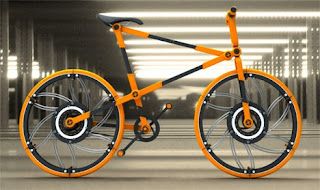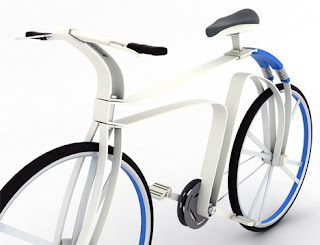In the four years that I have been writing this blog, I have run across a number of concept bikes that I have chosen not to post simply because they didn’t look like they would work. I guess it just depends on the timing though, because in that same four years I have chosen to go ahead and post a number of bike renderings that I thought had an element of interest, but that I knew were flawed in some aspect of their functionality. It is something that I consider on a case by case basis, but my general rule of thumb for design submissions or designs that I find on the web is that they are post worthy if some element in the design is interesting or might generate a meaningful discussion. That doesn’t mean I have to like every concept that I post, but I DO have to see some value in throwing it out there.
Why do I bring this up now you might ask? Well, last week I had a discussion (via twitter) with DL Byron of BikeHugger about some of the flashy concept bike renderings out there, which are seemingly created just to get exposure on blogs. He left a comment along those lines on a recent Treehugger post about Victor Aleman’s ECO 07 folding bike calling it, “yet another cad drawing concept making the blog rounds.” He went on to say, “ Should have an acronym for that: YACC or DBF for design blog fodder.”
No doubt some bike renderings that we see on the web are created just to get the designer a little exposure…and I don’t really have a problem with that. If a talented furniture designer like Mr. Aleman wants to design a bicycle for his portfolio, then I say more power to him. If that concept happens to spread all over the web by way of the design and lifestyle blogs, even better. I may personally have a few issues with the design of the ECO 07 bike, which breaks into many little pieces in order to fit in a case that is only slightly smaller than a folded Brompton, but I AM always glad to see conceptual bike designs getting exposure in non-bike circles. Many of the “designer bikes” that spread like wildfire around the blogosphere reach people who would probably not be looking at a bicycle otherwise. If those people have a positive reaction to a designer’s “blue sky” concept bike, I think that is a good thing.
Another concept bike, which I saw last week on Yanko Design (an excellent design blog by the way), is the Hidemax by Servet Yuksel. According to the post, the bike was “born out of the notion to enhance speed, functionality, looks, comfort, resistance and durability.” Not everyone agrees with that though. The comments on that post range from “very cool” and “beautiful” to “hideous, ridiculous, unrealistic and useless.” Personally, I tend to agree with commenter zippyflounder who said ‘This is not impossible just very inefficient. The biggest goof is every time you push the pedals you are putting tension on the chain, causing the rear forks and the crank support to bend together.” Regardless of whether the design is efficient or not, the important thing is that it has people talking. In general, concept bike renderings like these on design blogs generate more heated comments than other types of product. From a design point of view, I don’t think those strong reactions are necessarily a bad thing either. I would much rather design an object that elicits a very strong emotional response, love or hate, than one that everyone just looks at and says, “yeah, it is OK.” Again, whether you like the design or not, the discussion is the good part.
I have ridden bikes all my life, but when I started racing in the mid 80s my interest in bicycles and cycling really started to deepen. At that point, I read as much as I could about bicycle history and framebuilding. I worked as a bike mechanic in high school and college and I experimented with my own bikes to see what minor tweaks might gain me a bit of speed. My interest in bikes has never waned and eventually expanded beyond just racing bikes, so today I feel like I know quite a bit about bicycles in general and how they work. I do , however, realize that intimate knowledge of a subject can sometimes make it more difficult to accept ideas that deviate from the status quo. That is why I like seeing fresh ideas from young designers with less cycling experience that I have. I may not always agree with them, but there is usually an element of interest that makes me glad to see the design. Based on some the comments about conceptual designs that I have posted in the past though, I don’t expect everyone to agree. If “blue sky” concept bikes bother you, I am interested to know why. They are just concepts after all…no need to feel threatened by them.



Leave a Reply